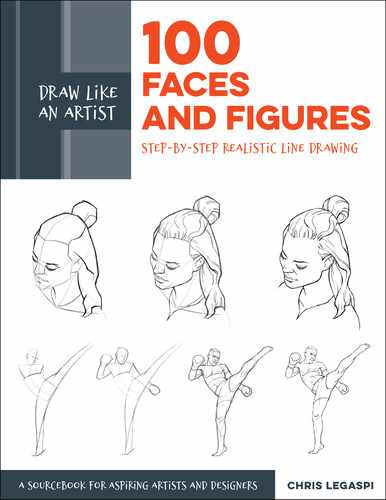TIPS FOR BETTER LINE CONTROL
Because the drawings in this book are line drawings, here are some tips and ideas on how to make better lines. The art of making better lines is known as “line control.” Even though we are using only lines to draw realistic feeling figures, with good line control, our drawings can become more dynamic and life-like.

TIP #1: DRAW WITH YOUR WHOLE BODY
Most artists draw with a limited range of motion, using only their hand and wrist. This is known as “wrist drawing.” A more skilled approach is to use as much of your arm and body as possible whenever you make a line or a mark. Most art teachers and professionals will suggest that you draw with your arm, but I try to use my whole body as much as possible, from my wrist all the way down to my legs! Moving your whole body adds so much more life and movement to every mark you make.

EXERCISE
Using a 18" × 24" (46 × 61 cm) or larger paper or chalkboard, draw standing up. Use your favorite drawing tool and make a page of long lines using large strokes. As you draw, move your entire body and exaggerate your movement. For example, as I draw from left to right, I will move my entire body, from my legs to my hand, in the direction of my stroke as my hand and the pencil move across the paper.
TIP #2: ALWAYS “DRAW THROUGH”
When drawing forms such as figures or faces, make a habit of drawing the complete form, even the back side of the form or parts of the form you can’t see. This is called “drawing through” because you literally draw lines through the form or other overlapping forms. For example, when drawing the outer shape of a face, draw all the way through to the back of the head even though you can’t see it.

EXERCISE
Draw a simple sphere shape and then draw an elliptical line that cuts the sphere in half vertically and horizontally. Make sure to draw all the way through the sphere and imagine the back side of the sphere. Next, draw a cylinder and make a series of elliptical lines along the cylinder. Repeat this with cube and rectangular forms, then move on to complex forms such as faces and figures.
TIP #3: VARY THE LINE THICKNESS
Instantly make your lines look more interesting, more dynamic, and more professional by simply varying or changing the thickness of the lines as you draw. This means varying the line from thick to thin within a single stroke or changing line weight. For example, if you start with a thin line, make it thicker, then go back to thin. If you start drawing a thick line, change to a thinner line as you go. Line weight is fundamental to good line control. In the following tips, I’ll discuss more specific ways to use line weight.

EXERCISE
Use an ink fountain pen or brush pen to practice. As you make lines, change the angle of the tip or the pressure you apply to the tip to get thicker lines, then lift the pen off the paper to get thin lines. Fill a page with thick to line lines once a day or before every drawing session.
TIP #4: USE LINE WEIGHT TO SUGGEST LIGHT AND SHADOW
One way line weight can make a drawing better is by suggesting light and shadow. For example, if I want to suggest a light from above, I will make thin lines at the top of the form and thicker lines at the bottom. The thin lines will feel lighter and be brighter, while the thick lines will feel darker like they are in shadow.

EXERCISE
Draw simple household objects like fruit or a coffee cup. Use thick or thin lines to suggest a light source from above. Next, draw the same object and use thick or thin lines to suggest a light source coming from the left or the right. Once you are comfortable with simple objects, do the same with more complex subjects such as faces and figures.
TIP #5: USE THICK LINES AT INTERSECTIONS
Another way to use line weight is to make your lines thicker when two lines meet or intersect. When two lines intersect, it is often because one form is overlapping another or two forms are touching. For example, when the arm overlaps the torso, I will add a thicker line wherever the arm intersects the torso, suggesting an overlap and creating a feeling of three-dimensional depth. Whenever you make two lines intersect, take the opportunity to add variation in line weight.

EXERCISE
Create a still life of three simple objects like fruit or household objects and overlap one object in from of the other. As you draw, make each intersecting line thicker. Once complete, rearrange the objects by moving another object in front and another to the back and complete another line drawing, making sure to use thick lines at the new intersections.
